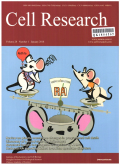- 钛学术文献服务平台 \
- 学术期刊 \
- 基础科学期刊 \
- 生物科学期刊 \
- 细胞研究(英文版)期刊 \
null
Solving the mystery of H7N9 by crystal balls
基本信息来源于合作网站,原文需代理用户跳转至来源网站获取
摘要:
Influenza A virus is subtyped by its two major surface proteins,the hemagglutinin (H1 to H18) that attaches the virus to host sialic acid receptor and the neuraminidase (N1 to N11,N10 lacks enzymatic function) that releases the progeny virus from infected cells by hydrolyzing the sialic acid receptor.Historically,seasonal and pandemic influenza due to human-to-human transmission are caused by subtypes of combinations of H1,H2 and H3 with N1 and N2.Since 1997,outbreaks or sporadic human infections due to avian-to-human transmission of avian influenza A virus subtypes H5N1,H9N2,H7N7,H7N2,H7N3,H10N7 and H6N 1 have been reported.Except for the H5N1 virus that killed nearly 60% of all reported cases,most of these human cases were self-limiting mild acute upper respiratory tract infections and conjunctivitis.However,in 2013,the H7N9 virus emerged in China,which has affected 135 patients with 45 deaths.This number of HTN9 patients is over three times the total number of H5N1 patients in China within the last ten years [1].Phylogenetic analysis of the human and avian virus isolates from epidemiologically-linked live poultry market suggested that patients acquired the H7N9 virus from contacts with live poultry [2].Furthermore,genetic analysis of these viral isolates showed evidence of mammalian adaptation.Two important questions have to be answered urgently.How does this novel virus jump from poultry to human and what drug treatment can be used to treat this disease with such a high mortality of 33%.

推荐文章
期刊_丙丁烷TDLAS测量系统的吸收峰自动检测
带间级联激光器
调谐半导体激光吸收光谱
雾剂检漏 中红外吸收峰 洛伦兹光谱线型
不同盐度、温度及光照对漂浮浒苔生理生态的影响
浒苔
盐度
温度
光照
生理生态
期刊_联合空间信息的改进低秩稀疏矩阵分解的高光谱异常目标检测
高光谱图像
异常目标检测 低秩稀疏矩阵分解 稀疏矩阵 残差矩阵
内容分析
关键词云
关键词热度
相关文献总数
(/次)
(/年)
引文网络
引文网络
二级参考文献 (0)
共引文献 (0)
参考文献 (0)
节点文献
引证文献 (0)
同被引文献 (0)
二级引证文献 (0)
2013(0)
- 参考文献(0)
- 二级参考文献(0)
- 引证文献(0)
- 二级引证文献(0)
引文网络交叉学科
相关学者/机构
期刊影响力
细胞研究(英文版)
主办单位:
中国科学院上海生化细胞所
出版周期:
月刊
ISSN:
1001-0602
CN:
31-1568/Q
开本:
16开
出版地:
上海岳阳路319号中科院上海生命科学研究院31B,401室
邮发代号:
4-645
创刊时间:
1990
语种:
eng
出版文献量(篇)
2692
总下载数(次)
0
总被引数(次)
40708
期刊文献
相关文献
推荐文献
- 期刊分类
- 期刊(年)
- 期刊(期)
- 期刊推荐
力学
化学
地球物理学
地质学
基础科学综合
大学学报
天文学
天文学、地球科学
数学
气象学
海洋学
物理学
生物学
生物科学
自然地理学和测绘学
自然科学总论
自然科学理论与方法
资源科学
非线性科学与系统科学
细胞研究(英文版)2022
细胞研究(英文版)2021
细胞研究(英文版)2020
细胞研究(英文版)2019
细胞研究(英文版)2018
细胞研究(英文版)2017
细胞研究(英文版)2016
细胞研究(英文版)2015
细胞研究(英文版)2014
细胞研究(英文版)2013
细胞研究(英文版)2012
细胞研究(英文版)2011
细胞研究(英文版)2010
细胞研究(英文版)2009
细胞研究(英文版)2008
细胞研究(英文版)2007
细胞研究(英文版)2006
细胞研究(英文版)2005
细胞研究(英文版)2004
细胞研究(英文版)2003
细胞研究(英文版)2002
细胞研究(英文版)2001
细胞研究(英文版)2000
细胞研究(英文版)2013年第9期
细胞研究(英文版)2013年第8期
细胞研究(英文版)2013年第7期
细胞研究(英文版)2013年第6期
细胞研究(英文版)2013年第5期
细胞研究(英文版)2013年第4期
细胞研究(英文版)2013年第3期
细胞研究(英文版)2013年第2期
细胞研究(英文版)2013年第12期
细胞研究(英文版)2013年第11期
细胞研究(英文版)2013年第10期
细胞研究(英文版)2013年第1期

 免费查重
免费查重










